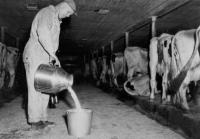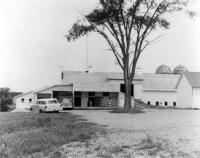When Cows Were King: The Crosby Barn Past And Present
By Cookie Steponaitis
| |
|
When this reporter was a child, she went looking for her first real job. The only problem was that she was seven years old and didn't know how to do too much. Walking down Crosby Heights into town, she stopped at the Crosby Barn and went in to see the owner, Edgar Crosby. Now, before you assume that furniture was her first job, guess again. At that time the barn held cows, and it was the center for commission sales in the region. When current owner Bub Crosby tells you in his advertisements that, “the cows paid for the barn, so you don't have to,” he wasn't joking. Under the guidance of the Crosby family, many of that generation got their first job, their first wage, and learned a great deal about cows, agriculture and the generosity of the Crosby family.
The construction of the Crosby Barn was started in November of 1931, with the cows following in March of 1932. At the time of construction the barn cost $16,000 and was one of the first gambrel balloon construction barns in New England. It measured 240X36X45 feet high. Today it is one of only a handful gambrel barns remaining in use today. While it originally was planned as a family cattle business, the cattle flourished and as early as 1945, local commission sales were held there. The last commission sale in the barn occurred in 1986.
For those of you unfamiliar with an auction business, it is a lively exchange and the barn was always packed with people. Dealers from New York and New England were heard bartering and discussing the animals at hand. On Monday and Thursday nights, owner Edgar S. Crosby and his son Bub were the hosts for visitors from as far away as California. Television reporters often recorded the events for local television spots and for the local farmers, it was a place to meet, discuss and see the latest in cattle.
Once the sale was complete one would assume the business was concluded. In fact, it was just starting. Cattle would be shipped for slaughter to Boston Market or to the homes of individual purchasers. During the early years of its operation, starting in Whiting in 1910, the B. Crosby & Sons was the largest shipping operations into the Boston market on this side of the Mississippi River. One shipping route went from Ogdensburg, New York and ran through Northern New York and Vermont. Once a week, the train would carry as many as four thousand head of cattle on each trip. Some calves left Vergennes and were air lifted to Europe. During the 1960's Italy had a cattle shortage and Crosby cattle flew calves out to Italy from Burlington, sending several thousand head.
As the agricultural landscape again changed in Vermont, so did the Crosby family business. In 1989, the 20,000 square foot barn went into its second phase of use. The Crosby family at that time went into the furniture business. “We opened with no real knowledge of furniture,” Bub Crosby recalls. Bub's wife Meg had studied interior design as well as restoring antiques. The size of the barn allowed the couple to diversify and include many different furniture projects. Now entering their twentieth year of operation, Bub's Barn has again become a destination for the next generation of those who call the “Little City” home.
So, if you come in and wander through the 20,000 square feet of Crosby Furniture Barn, while you are gazing in amazement at the variety and beauty of the products on display, close your eyes for a moment and visualize a different time. Imagine Holsteins and a time in our history when cattle in Vergennes were king. If you look close you might even see a seven year old, learning to put on a milking machine and seeing first hand how to work hard and to be proud of it.


